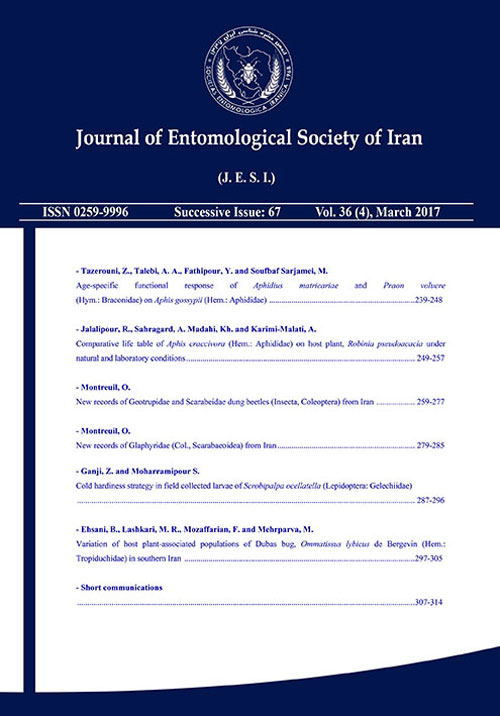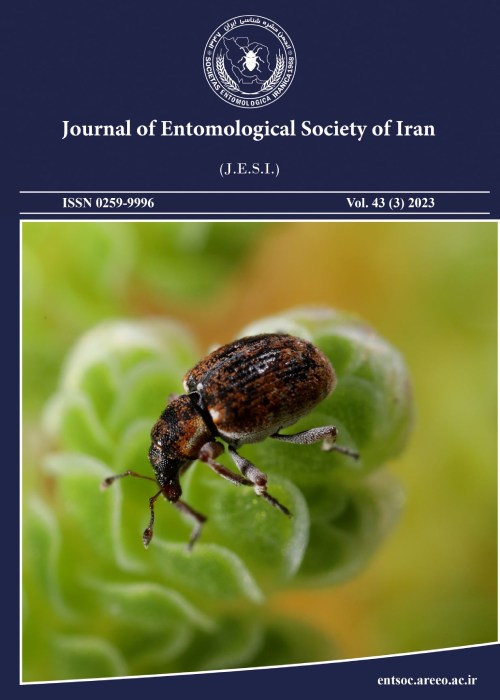فهرست مطالب

نشریه نامه انجمن حشره شناسی ایران
سال سی و ششم شماره 4 (پیاپی 67، زمستان 1395)
- تاریخ انتشار: 1396/01/06
- تعداد عناوین: 8
-
-
Pages 239-248The cotton aphid, Aphis gossypii Glover is a major pest of greenhouse cucumber in the world. In this study, age specific functional response of Aphidius matricariae Haliday and Praon volucre (Haliday) were investigated on A. gossypii at 25±1°C, 60±5% RH and a photoperiod of 14 L: 10 D h. The results showed that the functional response of A. matricariae was type III during 1st, 2nd, 3rd, 4th and 5th days and type II in 6th day of adult parasitoid lifetime. The type of functional response of P. volucre was type II in whole parasitoid lifetime. The highest b value (0.02±0.003 h-1) and the lowest handling time (Th) (0.70±0.013 h) of A. matricariae were observed in the 1st day of parasitoid lifetime. The maximum attack rate (T/Th) of A. matricariae occurred in the first day of parasitoid lifetime (34.28 nymphs). The maximum searching efficiency of P. volucre was determined in the 2nd and 3rd days (0.03±0.003 and 0.03±0.005 h-1) and the minimum handling time was recorded in the 2nd day (0.97±0.140 h) of adult female life. The maximum parasitism rate was 24.74 nymphs in the two day old female, and then decreased in adult female age. The results suggest that A. matricariae and P. volucre are highly effective biological agents in suppressing A. gosspii population on cucumber in greenhouses.Keywords: Functional response, Aphis gossypii, parasitoid, cucumber
-
Pages 249-257-The cowpea aphid, Aphis craccivora Koch, is an important pest of Robinia pseudoacacia Frisia. Life table parameters of A. craccivora were determined under natural (16- 33ºC and 32-89% RH, respectively) and laboratory (25 ± 1ºC, RH of 70 ± 5% and a photoperiod of 16:8 h (L: D) conditions. The data were analyzed using the age-stage, two-sex life table theory. Each experiment was replicated 45 times for each condition. There was significant differences between the survivorship, fecundity and longevity of the A. craccivora in laboratory and natural conditions. Under natural conditions, A. craccivora had a significant shorter nymphal developmental time, adult longevity and life span than those reared under laboratory conditions. However, the intrinsic rate of increase (r), net reproductive rate (R0), the finite rate of increase (λ) and gross reproductive rate (GRR) under laboratory conditions, were higher than those obtained in field, the higher mean generation time (T) was found in the field. All in all, the results of this study showed that two different conditions (field and laboratory) had significant influence on developmental times and life table parameters of A. craccivora and it is hard to escape the obvious conclusion that we must prevent the unsuitable extrapolation of laboratory results to field applications. The results obtained here, could also help us to understand the population dynamics of A. craccivora under field condition and to develop effective integrated pest management (IPM) programs.Keywords: Aphis craccivora, generation time, intrinsic rate of increase, life table parameters, natural condition
-
Pages 259-277New locality data are given for eight species of Geotrupidae and 65 species and sub-species of Scarabaeidae dung beetles from Iran. The species Onthophagus (Palaeonthophagus) anatolicus Petrovitz, 1962, and Onitis alexis ssp. septentrionalis Balthasar, 1942, are recorded for the first time from Iran.Keywords: Geotrupini, Bolbelasmini, Lethrini, Coprini, Onitini, Sisyphini, Oniticellini, Onthophagini, Gymnopleurini, Iran
-
Pages 279-285New distributional data are given for 27 species of Iranian Glaphyridae. Two of them, Glaphyrus calvaster Zaitzev, 1923, and Pygopleurus transcaucasicus (Petrovitz, 1962), are recorded from Iran for the first time. Further data on Glaphyridae species and their status in Iran is provided.Keywords: Glaphyrus, Eulasia, Pygopleurus, Iran
-
Pages 287-296The beet moth, Scrobipalpa ocellatella is recognized as a widespread agricultural pest. Cold hardiness strategy of the beet moth larvae was investigated through monitoring seasonal changes at supercooling points and lower lethal temperatures. Furthermore, the role of microhabitat in winter survival was studied. The mean SCPs of the last instar larvae was not significantly different from November 2010 to April 2011. Mean inoculative freezing point (-8.0 ± 1.44 °C) of the last instar larvae was significantly higher than mean SCP (-14.9 ± 0.93 °C). The cold hardiness of the pest shows seasonal fluctuation in response to reduction of air temperature. A 50% mortality (LT50) occurred at -11 ºC in November and -14 ºC in January and reduced to -18 ºC in February and finally increased to -14.5 ºC in April. Glycerol, sorbitol, trehalose, and myo-inositol were identified components in whole body extracts of S. ocellatella larvae. However, total cryoprotectants could not have significant effects on the cold tolerance. Larvae of S. ocellatella could tolerate subzero temperatures near their SCPs. Our findings show that beet moth larvae utilize moderately chill tolerance strategy during winter.
-
Pages 297-305Dubas bug, Ommatissus lybicus de Bergevin (Hem.: Tropiduchidae), is a key pest of date palms in Iran.This pest was first reported on date palms in 1966 and has been established throughout the date producing regions in southern Iran since. Date palm is the only host plant of Dubas bug. It attacks almost all date palm varieties, esp. Mazafati variety in city of Bam, Kerman Province and other varieties such as Halilei and Karoot. Using geometric morphometric method on forewings, we studied the morphological characters of host-associated populations of this pest. Adult Dubas bugs were collected on three varieties of date palms, Phoenix dactylifera L., including: Mazafati, Halilei and Karoot from Bam in 2015. For the analysis of wing shape and wing size, MANOVA and ANOVA were done, respectively. An allometric analysis was performed on the shape and size variables. The results of MANOVA indicated a significant difference (P0.05). The regression of shape on the size variables showed no significant allometric growth (P >0.05). The UPGMA tree, based on the Mahalanobis distances matrix, detected two distinct groups: the first group was a population feeding on the Mazafati variety with narrow wing shapes, and the second were populations feeding on Halilei and Karoot varieties with wide and shorter wing shapes. The observed forewing shape of individuals in population feeding on the Mazafati variety may change their flight abilities, and other biological aspects, such as survival.Keywords: date palm, Phoenix dactylifera, Tropiduchidae, biodiversity, Geometric morphometrics
-
Pages 307-310A total of 13 species of Coccomorpha (Hemiptera) from three scale insect families; Coccidae (3), Diaspididae (5) and Pseudococcidae (5) have been found on Ficus carica L. (Moraceae) in Iran. Diaspidiotus braunschvigi (Rungs) (Diaspididae) is recorded as new record in Iran, described and illustrated based on adult females. Species that have been previously recorded on F. carica, are listed, and the global distribution is given for each species.Keywords: Scale insect, Coccomorpha, Ficus carica, Diaspidiotus braunschvigi, Iran
-
Pages 313-314Poecilus beesoni (Andrewes) collected at lake Izeh (Khuzestan) is recorded for the first time for Iran. For identification the holotypes of Poecilus beesoni and P. affinissimus were compared. Based on this study Poecilus affinissimus (Ali 1967) is synonymized with Poecilus beesoni (Andrewes, 1927).Keywords: Poecilus beesoni, Carabidae, first record, Iran, new synonymy


